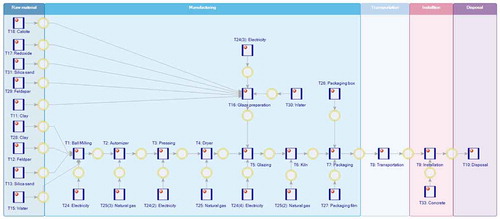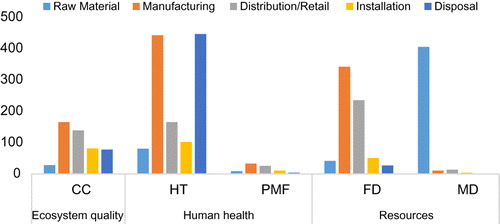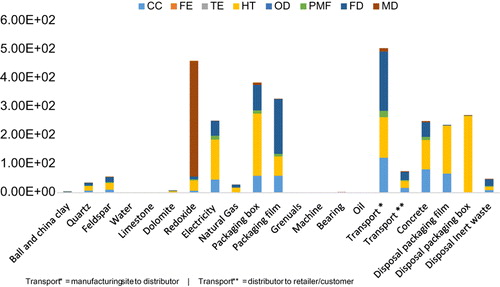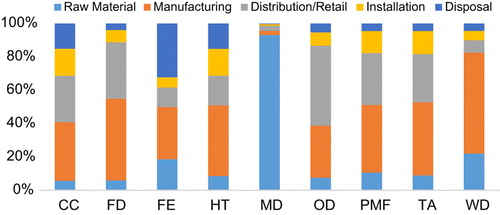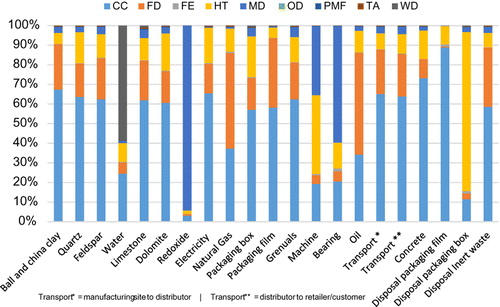Abstract
The beginning of the twenty-first century saw a surge in the growth of construction industry, particularly the housing sector in India. This led to the growing demand of ceramic tiles. This growth is responsible for large-scale consumption of natural resources and generation of solid waste. The objective of this paper is to assess the environmental impact of vitrified ceramic floor tile supply chain by performing life cycle assessment (LCA) following international standards of ISO 14040 series guidelines. The impact has been determined by conducting a LCA using Umberto NXT software (eco-invent 3.0 database) with ReCiPe endpoint and midpoint methods. It has been found that the manufacturing stage of supply chain is generating highest impact on environment in all the categories. Impact analysis of different input resources/material shows that red oxide used in glaze preparation, electricity in manufacturing, packaging material, distribution by trucks, installation of tiles using concrete and disposal of packaging material are responsible for most of the environmental impact. This study will offer the essential quantitative assessment to recognise the phases and materials which are highly responsible for the degradation of environment so that appropriate interventions by the different stakeholders can be planed.
1. Introduction
Due to the growing concern on the environment by government and society, industries have started to pay more attention to the issues like environmental pollution and resource depletion (Singh, Mittal, and Sangwan Citation2013). Today’s globalised business environment allows the organisations to leverage their core competencies to maximum advantage and outsource the non-core work globally. This means the organisation’s environmental footprint extends globally along the whole supply chain. Recently, Sutherland et al. (Citation2016) also emphasised the lack of social indicators along manufacturing supply chains and highlighted the existence of challenges to start and operationalise sustainability in social aspect, especially in the manufacturing domain. Most of the research in LCA has been in the manufacturing and use phases. The other parts of the supply chain have been ignored in LCA studies. It may be true for automotives and electrical and electronic equipment (EEE) like lighting systems, refrigerators & air-conditioning equipment where major environmental impact comes from the use phase and disposal phases. On the other hand, use and disposal phases of ceramic products may not have much environmental impact but their distribution phase may have substantial environmental impact. Therefore, organisations have to make sure that their all supply chain activities are environmental friendly and sustainable. Measurement of environmental impact along the whole supply chain is crucial to improve sustainability because without measurement; control and improvement are impossible (Olugu, Wong, and Shaharoun Citation2011). LCA can be used as a technical tool to measure or evaluate the environmental consequences of a product or service in their entire life cycle (Curran Citation2013; Ingarao et al. Citation2016). It is a method to evaluate environmental impact related with all the phases of a product or service life from cradle to grave (i.e. extraction of raw material with its processing, manufacturing of product, distribution to customer, use by customer, repair and maintenance while use, and end of life approaches after use) (Klöpffer Citation1997). The sustainability of construction technologies and products is usually described and presented in a general manner which does not contain any valid calculation but with the introduction of LCA every construction product must now be accompanied by a calculated inventory of its environmental impact and potential benefit in order for its sustainability to be validated (Zygomalas and Baniotopoulos Citation2013).
World ceramic tile production is 11,913 million m2 and growing with the rate of 11%. China is leading manufacturer of ceramic tile in the world with total production 5200 million m2 (TERI Citation2012). Ceramic industry of India has shown fast growth in last decade because of the growth in construction, housing and power sectors. This growth has escalated demand for insulators, sanitaryware and tiles of different types (Sangwan, Bhamu, and Mehta Citation2014). India is the third largest manufacturer of the ceramic tiles in the world with the total production of 850 million m2 in 2015. This sector is growing at a rate of 15% which is much higher than the world growth rate (Baraldi Citation2016; ICCTAS Citation2015). However, this rapidly growing industry is consuming large amount of natural resources and producing waste in large quantities. Every ceramic product has three main phases (i.e. pre-kiln, kiln and post-kiln operations) in production process. Defective product can be recycled before kiln operation but after firing in kiln product has to be discarded, which cause waste disposal problem and become the reason for wastage of 90% energy (Bhamu and Sangwan Citation2015). Ibanez-Fores, Bovea, and Simo (Citation2011) conducted a LCA study of ceramic tiles in direction to recognise the stages, materials and processes, which contribute maximum in environmental impact. They had collected yearly data for different stages of ceramic tile supply chain from 35 organisations of Spain. This study shows environmental impact in five different midpoint category (i.e. global warming, ozone layer depletion, acidification, eutrophication, photochemical oxidation and human toxicity) for each organisation and each phase of the life cycle. Gabaldón-estevan, Criado, and Monfort (Citation2014) analysed the effect of environmental issue and their interrelationship with innovation systems, throughout the industry value chain, for the Spanish ceramic tile industry. The socio-economic and environmental impact of the industry has also been reported. Gupta et al. (Citation2015) has discussed the driver and barrier of green and sustainable manufacturing and measured the effects of these paradigms on industrial performance. This paper concludes that ceramic tile industry put major impact on environment due to the use of resources and generation of waste in large quantity. Here, in this study we are focusing on one single unit at each stage of ceramic tile supply chain in India. Also, in this study environmental impact has been measured in eight different endpoint categories and nine different midpoint categories. These impact categories will be helpful to clearly show the environmental damage made by the ceramic tile supply chain in each stage, material used and processes.
The goal of this case study is to assess the environmental impact of vitrified ceramic floor tiles using LCA. A case study has been done at XYZ Pvt. Ltd. The actual name of the organisation is not given to maintain confidentiality. The organisation is the biggest player in ceramic tile manufacturing sector in India with the total production of 41 million m2 per annum at its various plants. The manufacturing plant of XYZ Pvt. Ltd. considered in this case study have daily production of 8000 m2 of ceramic tile.
2. Materials and methods
LCA has been conducted by following guideline of ISO 14040 standard. This study conducted by encompasses four standard stages. It starts from the definition of goal and scope for this study, inventory analysis of collected data, impact assessment in different categories and then ends by interpretation of results (International Standard Organization Citation2006).
2.1. Goals and scope
The goal of this paper is to conduct a LCA of ceramic tiles (vitrified) in order to identify the hotspots in the supply chain. A hotspot is an activity in the supply chain which produces high environmental impact. This study also identifies the materials and manufacturing processes that put the major involvement in environmental impact along the whole supply chain. These impacts are categorised according to endpoint and midpoint impact categories. The scope of this work is a LCA from cradle to grave. This means that starts form the extraction of different raw material used in the production of vitrified tiles and ends with final disposal of ceramic waste.
2.2. System boundaries and functional unit
The system boundaries contains all upstream and downstream processes, input materials, and, waste and emissions produced from them, which are considered for analyses in this study (Rebitzer et al. Citation2004). In this study, all the supply chain activities in production of ceramic tile (i.e. raw material extraction, manufacturing of ceramic tile, distribution to different regions, installation of tiles using concrete, and finally disposal of packaging and construction waste) is considered as system boundary. The basic structural Umberto model of energy and material flow is shown in .
Here, functional unit used to calculate environmental impact is production and distribution of 1 m2 of ceramic tile (weight 22 kg, thickness 11 mm) for the time span of 20 years. In functional unit life of ceramic tile is considered 20 years as claimed by Carani et al. (Ibanez-Fores, Bovea, and Simo Citation2011).
2.3. Life cycle inventory and assumptions
Primary data for the study are collected from a large-scale tile manufacturing unit in India. Data of raw material and resources required in manufacturing (electricity, natural gas, packaging material, etc.) are observed form the industry by closely observing each process and by conducting a semi-structured interview with the managers. The tile distribution network of the organisation was examined to obtain the mean distance travelled by the tiles from manufacturing site to retailers. The type of transportation used from manufacturing site to retailer was also examined. Quantity of concrete used during the installation of tiles was obtained from the guideline given on the company website for the installation of floor tiles. Eco-invent 3.0 had been used as secondary data source. To model the environment impact of ceramic floor tiles, the data obtained both from the primary and secondary data bases have been combined.
The assumptions involved in this study are – first, the production of equipment, buildings and labour consumption for the production are not calculated as part of the predefined system. Second, ferrite production data are used in glaze preparation in place of redoxide as both have the same chemical composition. Three, there is no separate data available for ball and china clay extraction so clay production data have been considered for both.
2.4. Life cycle impact assessment (LCIA)
LCIA results have been generated with ReCiPe endpoint and midpoint methodology using Umberto NXT software. ReCiPe endpoint, which lets environmental effect in a single score, is designed around three major damage categories of ecosystem quality, human health and resources. Ecosystem quality has been measured by the climate change (CC) potential. Two subcategories of the human health which were found significant in this study are – human toxicity (HT) and particulate matter formation (PMF). Fossil depletion (FD) and metal depletion (MD) have been considered for the resources category. Midpoint assessment has been done for nine different environmental impact categories – climate change (CC), fossil depletion (FD), freshwater ecotoxicity (FE), human toxicity (HT), metal depletion (MD), ozone depletion (OD), particulate matter formation (PMF), terrestrial acidification (TA) and water depletion (WD).
3. Results and discussion
3.1. Endpoint assessment
The results of endpoint environmental impact assessment of ceramic tile supply chain are shown in Figures –. Also detailed results are given in Appendix 1. As observed from , manufacturing phase has dominating impact on ecosystem quality and human health categories because of the use of electricity, natural gas, heavy machinery and resources in tile production. The raw material phase shows significant impact on ‘resources’ category due to depletion during extraction. All product life phases have significant effect on human health but the effect during manufacturing and disposal phases is high. This is primarily because of the manufacturing and disposal of packaging box and film as harmful and toxic emissions are produced during the manufacturing and disposal of packaging box and film. The packaging is used for safe transportation and film is used to prevent scratching during transportation and handling. The film can be avoided by having a better packing at corners that also prevents the tiles to come in contact with each other. It was also observed that most of the damage to the tiles is at corners and the proposed packing avoids film and will reduce the corner breakage.
shows the impact of major subcategories of the endpoint assessment. The climate change potential of the study comes from the manufacturing phase and distribution phase. Installation and disposal phases also contribute to climate change potential because of concrete use and inert waste disposal, respectively. Human toxicity is mainly due to manufacturing and disposal phases. Particulate matter formation is an important parameter in tile manufacturing but its impact is not harsh. This is mainly because the plant is new and takes care that the transportation is done by eco-efficient lorries. Fossil depletion is found to be more important in manufacturing and distribution phases because of fossil fuel used in kiln and transportation. The metal depletion is maximum during the extraction phase due to disposal of packaging material extraction and redoxide extraction. Other subcategories like freshwater ecotoxicity, terrestrial acidification, ozone depletion do not have significant impact during the study but their values are given in Appendix 1 for future researchers.
shows impact by each material/resource used in the ceramic tile supply chain including manufacturing and identify the hotspots. It shows that use of redoxide in glaze preparation, use of electricity during manufacturing, packaging material of tile, long-distance transportation (manufacturing site to distributor), concrete used in installation and disposal of packaging material have high impact on environment. Ball clay, china clay, feldspar, water used in slurry and glaze preparation, natural gas, and ceramic tile waste disposal are showing less impact on environment. These results show that there is a need to identify alternate packaging material, glaze material, material for installation and renewable power source. High impact due to transportation explains that most of ceramic industries in India are situated near to the raw material source and this necessitate the large distance travel for the distribution of tiles across the country.
3.2. Midpoint impact assessment
Midpoint environmental impact assessment results have been shown in Figures and . Detailed results of nine categories in every phase of ceramic tile supply chain are given in Appendix 2.
Midpoint assessment in confirms the results identified in endpoint assessment that the manufacturing and distribution of tiles have high impact on environment, followed by raw material, disposal and installation phases. Manufacturing phase has highest impact on climate change, fossil depletion, human toxicity, particulate matter formation, terrestrial acidification and water depletion. Manufacturing is dominating in water depletion because lot of water is used during the production of tiles. This leads ceramic industries to think about the recycling of water in place of disposal. Use of clay and sand also leads to particulate matter formation. Fossil depletion is due to the use of natural gas in kiln, dryer and automiser. Distribution phase contribution is significant in ozone depletion potential because burning of fuel is harmful for ozone layer.
shows that climate change is highly impacted by almost all the material and resources used in the supply chain of ceramic tiles apart from redoxide. Redoxide, which is used to make glaze, has a high environmental impact on metal depletion category. Most of the resources also contribute to fossil depletion and human toxicity as shown in . However, the effect on human toxicity is high due to the corrugated packaging box used for the packaging of tiles.
4. Conclusions, future research directions and limitations
This study presents the environmental impacts of a ceramic tile supply chain in India using life cycle analysis. This study has found that manufacturing phase followed by distribution, disposal, raw material extraction and installation phases affect environment. The high environmental impact is observed on climate change, human toxicity, fossil depletion and metal depletion categories. These environmental effects are primarily due to the packaging material production and disposal, red oxide in glazing, electricity used for processes, concrete used during installation of tiles, and transportation of tiles to the distributors and retailers over long distances. An integrated packaging system is proposed to reduce the harmful effect of packaging box and film.
This study is expected to be useful for the ceramic industries to identify the process, phases and materials having high environmental impact and find environment friendly solutions. Top management can take decisions on future strategies to encounter future harsh environmental regulations. This study is also useful for the government agencies for the drafting new laws and regulations for the protection of environment.
There limitation of this study is that the data have been collected from ceramic tile supply chain of one large-scale plant. Apart from that impact due to the transportation of product from retailer to customer has not been considered because of lake of availability of data about the distance and mode of transport. Authors suggest future research to compare and benchmark the environmental impact from ceramic tile supply chains of different size plants situated at different locations. Future research can also focus on comparison of impact from different product made of ceramic materials.
Disclosure statement
No potential conflict of interest was reported by the authors.
Notes on contributors
Kuldip Singh Sangwan is a professor of Mechanical Engineering at Birla Institute of Technology and Science Pilani, Pilani Campus. His research interests are in the areas of sustainable manufacturing, life cycle assessment, integrated supply chain design and management, lean manufacturing, resource efficiency, metal cutting, etc.
Kailash Choudhary is a research scholar in the Department of Mechanical Engineering at Birla Institute of Technology and Science, Pilani, Rajasthan, INDIA. His research interests are primarily in the field of green supply chain management, life cycle assessment and benchmarking.
Chirag Batra completed his graduation in the discipline of Mechanical Engineering from Birla Institute of Technology and Science, Pilani, Rajasthan, INDIA in 2017. His research interests are primarily in the field of manufacturing engineering, supply chain management and operations research.
References
- Baraldi, Luca. 2016. “World Production and Consumption of Ceramic Tiles.” Ceramic World Review 103: 48–54.
- Bhamu, Jaiprakash, and Kuldip Singh Sangwan. 2015. “Reduction of Post-Kiln Rejections for Improving Sustainability in Ceramic Industry: A Case Study.” Procedia CIRP 26: 618–623. doi:10.1016/j.procir.2014.07.176.
- Curran, Mary Ann. 2013. “Life Cycle Assessment: A Review of the Methodology and Its Application to Sustainability.” Current Opinion in Chemical Engineering 2 (3): 273–277. doi:10.1016/j.coche.2013.02.002.
- Gabaldón-estevan, D., E. Criado, and E. Monfort. 2014. “The Green Factor in European Manufacturing: A Case Study of the Spanish Ceramic Tile Industry.” Journal of Cleaner Production 70: 1–9. doi:10.1016/j.jclepro.2014.02.018.
- Gupta, Rohit Kumar, R. S. Rajesh Purohit, Shelar Dipak Rana, and Ashutosh Mishra. 2015. “A Review on Green and Sustainable Manufacturing & their Impact on Social, Economical, Environmental Prospects.” International Journal on Applications in Science, Engineering & Technology 1 (1): 8–12.
- Ibanez-Fores, V., M. D. Bovea, and aSimo. 2011. “Life Cycle Assessment of Ceramic Tiles. Environmental and Statistical Analysis.” International Journal of Life Cycle Assessment 16 (9): 916–928. doi:10.1007/s11367-011-0322-6.
- ICCTAS. 2015. “Indian Council of Ceramic Tiles and Sanitaryware (ICCTAS).” http://www.icctas.com/ceramic-tiles-industry-in-india.htm.
- Ingarao, Giuseppe, Steven Licata, Marzia Sciortino, Diego Planeta, Rosa Di Lorenzo, and Livan Fratini. 2016. “Life Cycle Energy and Co2 Emissions Analysis of Food Packaging: An Insight into the Methodology from an Italian Perspective.” International Journal of Sustainable Engineering 7038 (Feb. 2017): 1–13. doi:10.1080/19397038.2016.1233296.
- International Standard Organization. 2006. “ISO 14044, Environmental Management — Life Cycle Assessment — Requirements and Guidelines.” Environmental Management 54: doi:10.1136/bmj.332.7555.1418.
- Klöpffer, Walter. 1997. “Life Cycle Assessment.” Environmental Science and Pollution Research 4 (4): 223–228. doi:10.1007/BF02986351.
- Olugu, Ezutah Udoncy, Kuan Yew Wong, and Awaludin Mohamed Shaharoun. 2011. “Development of Key Performance Measures for the Automobile Green Supply Chain.” Resources, Conservation and Recycling 55 (6): 567–579. doi:10.1016/j.resconrec.2010.06.003.
- Rebitzer, Gerald, T. Ekvall, R. Frischknecht, D. Hunkeler, G. Norris, T. Rydberg, W. P. Schmidt, S. Suh, B. P. Weidema, and D. W. Pennington. 2004. “Life Cycle Assessment Part 1: Framework, Goal and Scope Definition, Inventory Analysis, and Applications.” Environment International 30 (5): 701–720. doi:10.1016/j.envint.2003.11.005.
- Sangwan, Kuldip Singh, Jaiprakash Bhamu, and Dhwani Mehta. 2014. “Development of Lean Manufacturing Implementation Drivers for Indian Ceramic Industry.” International Journal of Productivity and Performance Management 63 (5): 569–587. doi:10.1108/IJPPM-06-2013-0105.
- Singh, Perminder Jit, Varinder Kumar Mittal, and Kuldip Singh Sangwan. 2013. “Development and Validation of Performance Measures for Environmentally Conscious Manufacturing.” International Journal of Services and Operations Management 14 (2): 197–220. doi:10.1504/IJSOM.2013.051829.
- Sutherland, John W., Justin S. Richter, Margot J. Hutchins, David Dornfeld, Rachel Dzombak, Jennifer Mangold, Stefanie Robinson, et al. 2016. “The Role of Manufacturing in Affecting the Social Dimension of Sustainability.” CIRP Annals – Manufacturing Technology 65 (2): 689–712. doi:10.1016/j.cirp.2016.05.003.
- TERI. 2012 “Widening the Coverage of PAT Scheme Sectoral Manual – Ceramic Industry.” https://www.scribd.com/document/261828099/Widening-of-PAT-Sectors-Shakti-Sustainable-Energy-Foundation
- Zygomalas, Iordanis, and Charalambos Baniotopoulos. 2013. “Life Cycle Assessment Environmental Data for Structural Steel Construction in Greece.” International Journal of Sustainable Engineering 7 (Jan.): 1–11. doi:10.1080/19397038.2012.756951.

